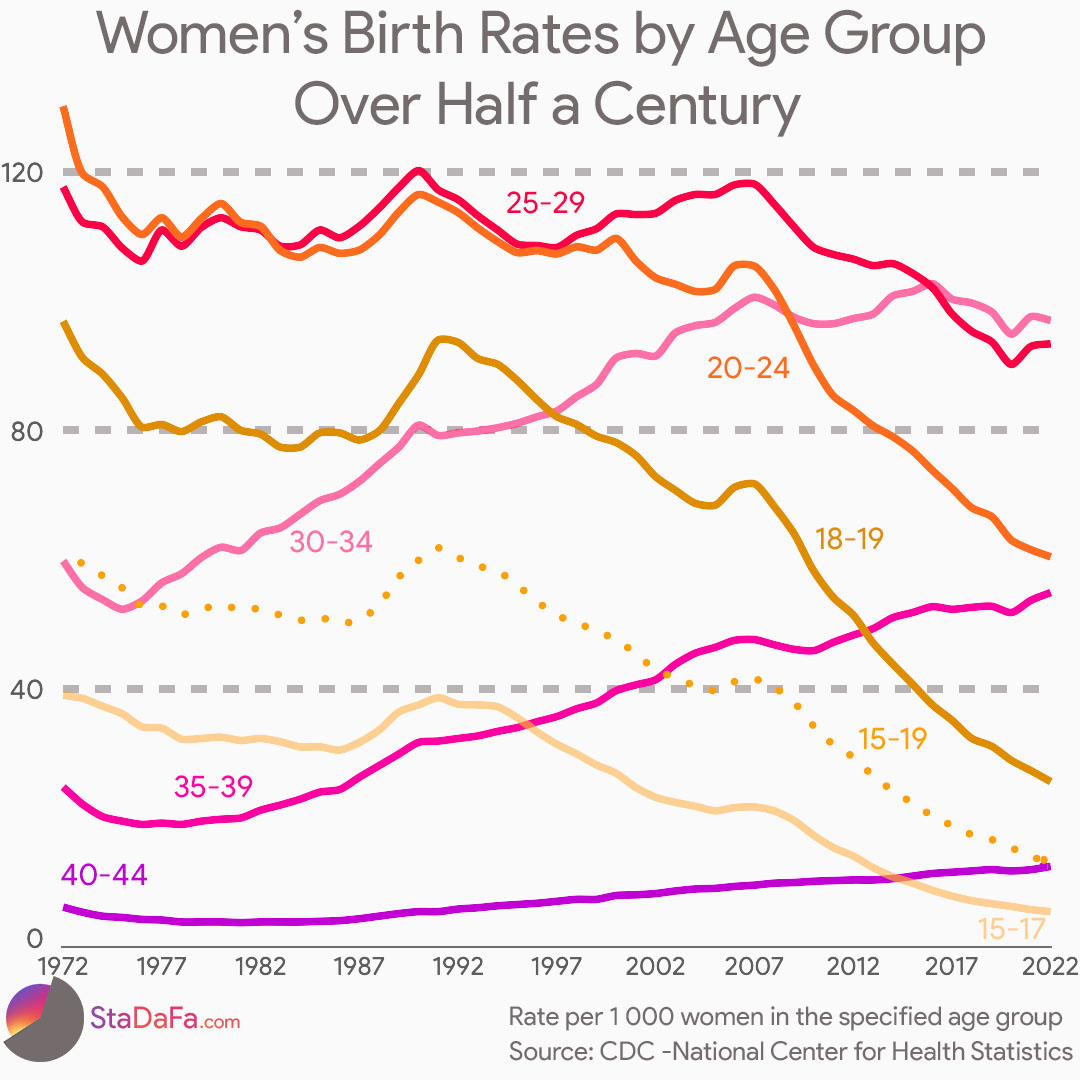This week we take a look at Women's Birth Rates by Age Group. In the ever-evolving landscape of demographics and societal trends, birth rates among women have seen remarkable shifts over the years. To shed light on this topic, I've put together a graph depicting the birth rates of women across different age groups. Let's dive into the intriguing findings.
The Decline in Teenage Birth Rates:
In 2022, the birth rate for teenagers aged 15-19 hit an all-time low, standing at 13.5 births per 1,000 females. This marks a staggering 78.2% decrease from the peak rate of 61.8 births per 1,000 females in 1991. This substantial drop represents an important achievement in public health and education. Young adults are increasingly making informed choices about their reproductive health, emphasizing the importance of sexual education and access to contraception.
Age-Specific Trends
When we delve deeper into teenage birth rates, the numbers reveal an even more significant transformation. In 2022, the rates were 5.5 and 25.6 births per 1000 females, respectively, down by 85.9% and 73.6% from 1972, which marked 50-year record highs for both groups. This suggests that the decline in teenage pregnancies is a widespread and long-term trend, rather than an anomaly.
For females aged 10-14, the birth rate was 0.2 per 1,000 in 2022, representing an 87.5% decrease from the early '90s peak of 1.2. While not included in our graph, this age group's data adds to the narrative of declining birth rates among younger women.
Women in Their 20s: A Substantial Decline
Moving to the 20-24 age group, the birth rate in 2022 was 60.4 births per 1,000 women, down by 53.6% from the 1972 peak of 130.2. This shift highlights how women are choosing to delay childbirth until later stages of their lives.
Women in Their Late 20s to Mid-30s: Changes in Fertility
For women aged 25-29, the birth rate in 2022 was 93.4 per 1,000 women, a 28.7% decrease from the 1990 peak of 120.2. This data may reflect the changing priorities of women in this age group, as more are choosing to establish their careers and financial stability before starting families.
Meanwhile, women aged 30-34 experienced an increase in birth rates, with 97 births per 1,000 women, up 46.1% from the low of 1975. These trends signify changing fertility patterns in modern society.
Women in Their Late 30s and Early 40s: Rising Birth Rates
The 35-39 age group saw a substantial increase in birth rates, with 54.9 births per 1,000 women in 2022. This marks a 65.4% rise from the low of 1977. Notably, the number of births to women in their late 30s reached a record high in 2022. The rising number of births in this age group highlights changing societal norms and the influence of advancements in reproductive technology.
Women in Their 40s: A Continuous Increase
Among women aged 40-44, the birth rate in 2022 was 12.5 births per 1,000 women, representing a significant 69.6% increase from the low in 1981. This age group has experienced a steady rise in birth rates over the years, growing at an average rate of 3% annually from 1985 to 2022, possibly due to improved fertility treatments and changing perceptions of motherhood.
Women Aged 45-49: A Notable Uptick
Even for women aged 45-49, the birth rate increased to 1.1 births per 1,000 women in 2022, up by 81.8% from the low of 0.2 in 1991. While this group wasn't included in my graph due to the minimal rate, it's worth noting the upward trend in this age category.
It's also worth noting that 2022 was the first year in recorded history that women over 40 had a higher birth rate (13.6) than teenage pregnancies for the 15 to 19 age segment (13.5).
Conclusion
In conclusion, the birth rates among women across different age groups offer a rich tapestry of changing societal norms, economic, and medical factors. increased awareness, and evolving personal choices. It's clear that women are making more informed decisions about when to start their families, resulting in these significant shifts in birth rates.
UPDATE: Ι also made a graph with data that goes back to the 1940s. The birth rates picked at 260,6 per 1000 women aged 20-24 in 1957. That's more than 4 times the current levels for the same age group.



Comments
Post a Comment